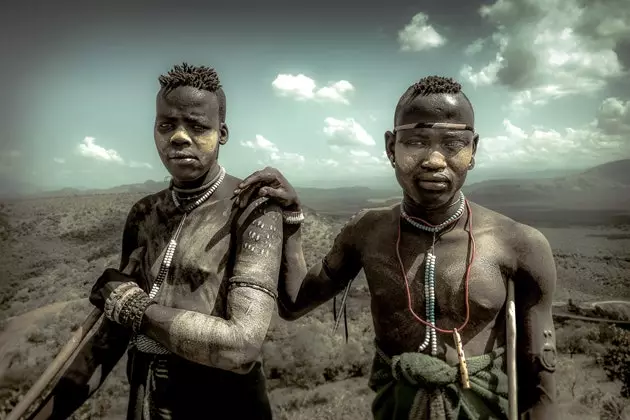
A direct look at the Mursi Warriors
1. TO READ THE SOUL OF THE OTHER, LOOK INTO THEIR EYES
Building trust is the key. If you want to connect with a stranger, look at him unblinkingly. Be interested in what can be read in them. The way of connecting through the gaze has an essential relevance for the photographer who wants to interact with a stranger in a foreign environment and in a strange country . In the same way that in a language words, in addition to strict meanings, represent cultural values, gestures and looks have different meanings in different cultures. For us, sometimes the direct look is a challenge, a provocation. In India the look "is read", it is everything . In television series, heroes stare into each other's eyes. In the streets of Varanasi too!
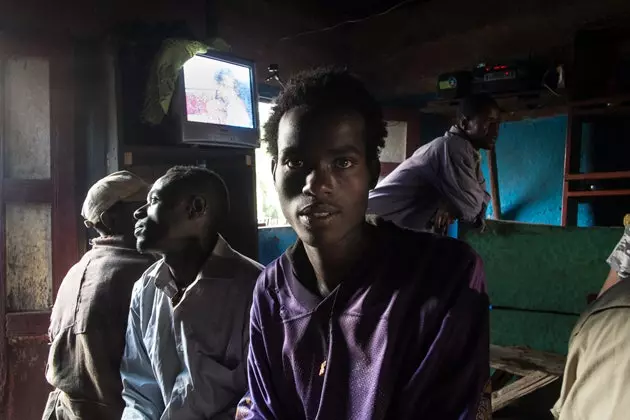
Ethiopia
2.THE SMILE: THE SOLUTION TO PROBLEMS
We all prefer kindness. The smile, together with the look, constitute the definitive weapon: it opens doors when they are closed, it obtains rooms in full hotels, it introduces cameras where they are prohibited. Straighten out misunderstandings. Change provisions. In many cultures, a serious, angry tone is a sign of rudeness that tends to block those who suffer from it. In many Asian countries, to deny you something they smile at you. They are not capable of serious denial. The truth is, to tell the whole truth, that by adding a small economic stimulus to a smile, a smile usually solves... 90% of problems.
3. SHARE A CUP, DRINK A TEA
Look for common elements . There is nothing like sharing experiences to make friends and... transcend cultural differences. Just as smiling is almost universal, so is sharing food and drinks. In all cultures, the invitation to drink is a gesture of good disposition. If you are not willing to share it - which I fully understand - at least show that you appreciate its culinary customs. Drink a tea in a dive, a brandy in a bar. The less common it is to see a foreigner or a tourist in the place, the greater the effect that you will produce among the locals.
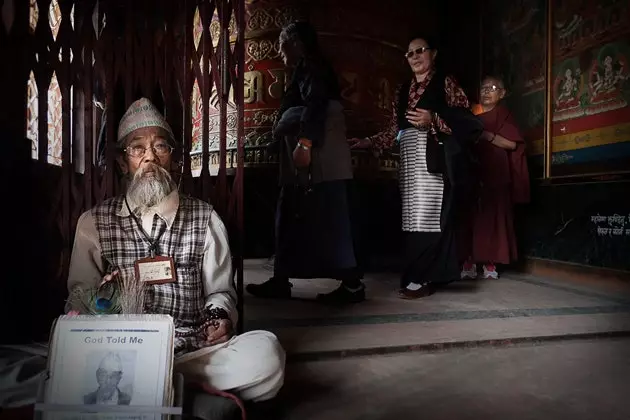
The smile, the infallible method
4.**“GÜER AR U FROM” (WHERE ARE YOU FROM)**
When some human warmth helps. In India I knew an English photographer who was very concerned about his safety. We met at a noisy fair, near the Kutch desert, on the border of the Rajhastan region. The man always used a telephoto lens to keep his distance from the native. For my part, as I always do, he enjoyed the short distance: a wide angle, a lens that requires proximity to the photographed.
The Englishman wanted to know if taking close-up photos had ever been a problem or an altercation. Sometimes –I replied laughing- I have had to suffer a “How are you, where are you from”!
Most of the time the problem is much more in our imagination than in reality. We start from a negative attitude, believing that the other is warned against us. In India, outside the cities, it is common for a passer-by to approach you and hold out his hand. Foreigners often jump back, scared. The trick is to accept the hand, looking straight into the eyes. The “How are you” It is the way to start a conversation, to create the relationship and... to learn English.
5. SAY HELLO IN THE LOCAL DIALECT. LEARN A FEW WORDS, DRESS PROPERLY
Get closer to the culture . The first impression is very important. It usually starts with outfit –we all classify others by their physical appearance- to continue with the look and finally by the words. Nothing generates more sympathy than seeing a foreigner making an effort to speak the local language . And if the language is a dialect, it is from a Mursi tribe, in Ethiopia, and little known... The victory is assured!
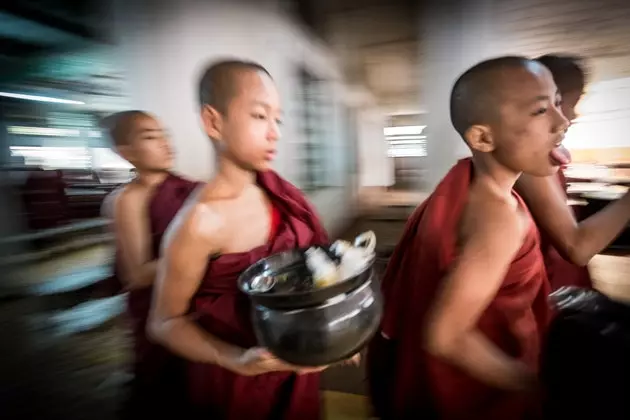
Monks starting their meal. Yangon. burma
6. MAGIC AND SURPRISE: THE UNIVERSAL LANGUAGE
Never miss an opportunity to surprise the stranger. A few years ago, in Rangoon (Yangon, Burma) it occurred to me to make a morning getaway to a group of temples that could be seen from the hotel. Five in the morning, it was not yet dawn. The camera in the right hand. At first light I find myself at the entrance of a Buddhist monastery, and at the door wide open, a nun, with a shaved skull, looks at me, smiles and, with a movement of her head, invites me to enter . In the gloom I follow her through endless corridors, finally arriving at a room in which I see, squatting on top of a pedestal, who must have been the main monk of the monastery. Breakfast, which had not started, was served on a large tray on the very floor of the room.
The priest did not seem too happy with my unexpected presence: face of few friends, look of angry censor directed at the nun who accompanied me. Awkward silence as we lock eyes. They don't speak my language, and I don't speak theirs either. I stare at the monk, hand the camera to the nun who was on my right and advance towards him without taking my eyes off him. As I do, I swagger up the sleeves of my shirt. When I'm a step away, I reach into my pocket for a coin, which I show off theatrically.
The monk adds surprise to the angry face . He does not understand what he intends and is convinced that the intruder, lout and inconsiderate tourist, is offering him -almost offending- with a ridiculous alms in his own house. I raise my hand to the sky to draw the eye to the coin and, enjoying the stupor that the gesture produces, I guide it to my mouth... Swallowing it! They look amazed. I let a few seconds pass while I move my jaws spectacularly in a gesture of difficulty in chewing it.
Another pause while I exaggerate the gesture of swallowing. I am enjoying knowing in advance the end of the act: I put my hand to my nose and squeeze it until -apparently- I get the coin I had swallowed to come out of it. Surprise . The monk's face no longer reflects anger. With both of his hands he shakes his head vigorously and... he bursts out laughing, elated like a little child!
From that moment the transformation took place. I went from being an awkward stranger to a friend who brought a gift, good humor and surprise. The rector devoted himself exclusively to me for the next hour, waking up the monks in their rooms and inviting them to pose for me.
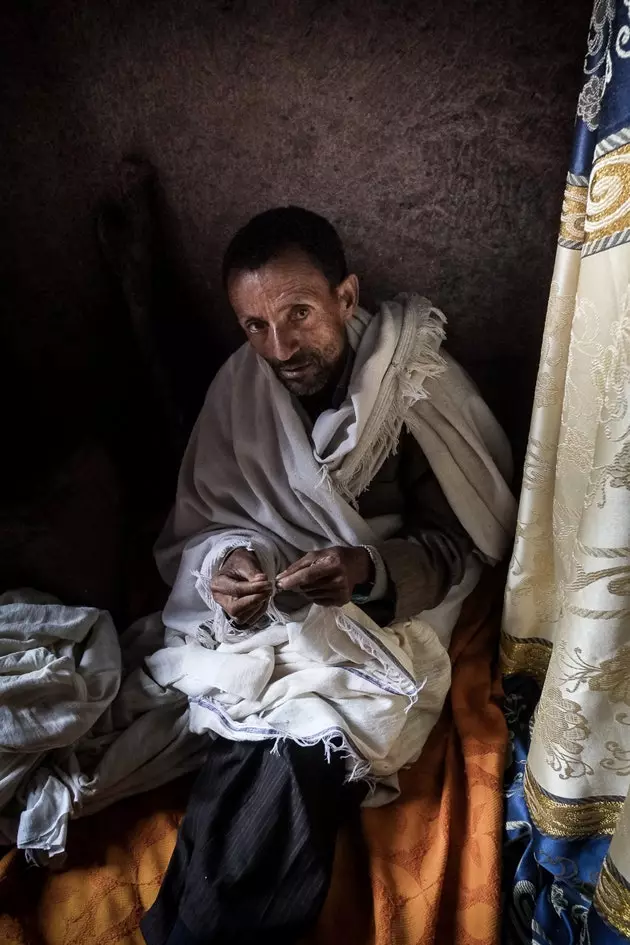
Learn some local words, interact with reality
* Harry Fisch, Founder of Nomad Photographic Expeditions, is Spanish despite the name, polyglot, originally a lawyer by training and a businessman, a photographer for more years than he cares to remember. He has made photographic trips to more than 30 countries specializing in Asia and, among other destinations, Thailand, Cambodia, Laos, Vietnam, Nepal and India. Selected in 2013 as a finalist in the Sony WorldPhoto Awards, in 2012 Winner of the National Geographic Photo, selected in 2010 by Photoespaña in its "Discoveries" section, in 2013 he obtained two Juror Awards of Merit in the French international Grand Prix of the Discover. His work has also been published in The letter of photography nominated as the best Blog of the year 2011 by the prestigious magazine LIFE.
*** You may also be interested in...**
- How to make your trip a trending topic
- Is travel photography possible without clichés?
- 25 photographs that every tourist should take
- 10 photos of your vacations that we DON'T want to see on Instagram
- The celebrities who use Instagram the most on their trips
- The 20 best travel accounts on Instagram
- 20 ideas to get the best summer selfie
- The 10 craziest places to take a selfie
